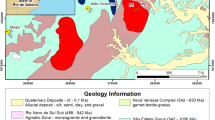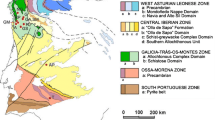Abstract
The relationship between the mechanical properties and petrographic features of granites from the Utla area, north-west Pakistan, was studied. Three different textural varieties of granites (megacrystic coarse-grained, fine-grained and foliated coarse-grained) were collected. Following a comprehensive petrographic analysis, their uniaxial compressive and tensile strengths as well their physical properties (porosity, water absorption and specific gravity) were determined. The modal concentrations, sizes and shapes of minerals as well as their distribution and alignment were analyzed during the petrographic observations. A detailed investigation utilizing statistical analysis revealed that megacrystic coarse-grained granites are stronger than the other two varieties because of greater variance in the grain sizes of their constituent minerals, their unaligned nature, lower abundances of micaceous minerals, and lower porosity and water absorption values.











Similar content being viewed by others
References
Akesson U, Stigh J, Lindqvist JE, Goransson M (2003) The influence of foliation on the fragility of granitic rocks, image analysis and quantitative microscopy. Eng Geol 68:275–288
Arif M, Mulk A, Tariq MM, Majid SH (1999) Petrography and mechanical properties of the Mansehra granite, Hazara, Pakistan. Geol Bull Univ Peshawar 32:41–49
Bell FG (2007) Engineering geology, 2nd edn. Butterworth–Heinemann, London
Brady BHG, Brown ET (2004) Rock mechanics for underground minning, 3rd edn. Kluwer, Dordrecht
Brown ET (1981) Rock characterization, testing and monitoring: ISRM suggested methods. Pergamon, New York
Bucher K, Frey M (1994) Petrogenesis of metamorphic rocks. Springer, Berlin
Commission of Engineering Geological Mapping of the IAEG (1979) Classification of rocks and soil for engineering geological mapping, part 1: rock and soil materials. Bull Int Assoc Eng Geol 19:364–371
Diamantis K, Bellas S, Migiros G, Gartzos E (2011) Correlating wave velocities with physical, mechanical properties and petrographic characteristics of peridotites from the central Greece. Geotech Geo Eng 29:1049–1062
Din F, Rafiq M (1997) Correlation between compressive strength and tensile strength/index strength of some rocks of North-West Frontier Province (limestone and granite). Geol Bull Univ Peshawar 30:183–190
Din F, Rafiq M, Mohammad N (1993) Strength properties of various building stones of N.W.F.P. Pakistan. Geol Bull Univ Peshawar 26:119–126
Farmer IW (1983) Engineering behavior of rocks. Chapman and Hall, London
Geological Society Engineering Group Working Party (1977) The description of rock masses for engineering purposes. report. Q J Eng Geol 10:43–52
Helibronner R (2000) Automatic grain boundary detection and grain size analysis using polarization micrographs or orientation images. J Struct Geol 22:969–981
Hencher SR, Martin RP (1982) The description and classification of weathered rocks in Hong Kong for engineering purposes. In: Proc 7th South-East Asian Geotechnical Conf, Hong Kong, China, 22–26 Nov 1982, 1:125–142
Herwegh M (2000) A new technique to automatically quantify microstructures of fine grained carbonate mylonites: two-step etching combined with SEM imaging and image analysis. J Struct Geol 22:391–400
Hussain A, Dipietro JA, Pogue KA, Ahmed I (2004) Geologic map of 43-B degree sheet of NWFP Pakistan. Geologic Map Series, map no. 11. Geological Survey of Pakistan, Quetta
ISRM (2007) The complete ISRM suggested methods for rock characterization, testing and monitoring: 1974–2006. In: Ulusay R, Hudson JA (eds) Suggested methods prepared by the Commission on Testing Methods, International Society for Rock Mechanics. ISRM Turkish National Group, Ankara
ISRM Commission on the Classification of Rocks and Rock Masses (1981) Basic geotechnical description of rock masses. Int J Rock Mech Min Sci Geomech Abs 18:85–110
Kempe DRC (1973) The petrology of the Warsak Alkaline granites, Pakistan, and their relationship to other alkaline rocks of the region. Geol Mag 110:385–404
Kempe DRC, Jan MQ (1980) The Peshawar Plain Alkaline Igneous Province, NW Pakistan. Geol Bull Univ Peshawar 13:71–77
Le Fort P, Debon F, Sonet J (1980) The “Lessor Himalayan” cordierite granite belt, typology and age of the Pluton of Mansehra, Pakistan. Geol Bull Univ Peshawar 13:51–62
Le Fort P, Debon F, Sonet J (1983) The Lower Paleozoic “Lesser Himalayan” granite belt: emphasis on Simchar Pluton of Central Nepal. In: Shams FA (ed) Granite of Himalayas, Karakoram and Hindukush. Institute of Geology, Punjab University, Lahore, pp 235–256
Le Maitre RW (2002) Igneous rocks: a classification and glossary of terms, 2nd edn. Cambridge University Press, Cambridge
Lindqvist JE, Akesson U, Malaga K (2007) Microstructure and functional properties of rock materials. Mater Charact 58:1183–1188
Lundquist S, Goransson M (2001) Evaluation and interpretation of microscopic parameters vs. mechanical properties of Precambrian rocks from the Stockholm region, Sweden. In: Proc 8th Euroseminar on Microscopy Applied to Building Materials, Athens, Greece, 4–7 September 2001, pp 13–20
McPhie J, Doyle M, Allen R (1993) Volcanic textures. Centre for Ore Deposits and Exploration Studies, University of Tasmania, Hobart
Pomonis P, Rigopoulos I, Tsikouras B, Hatzipanagiotou K (2007) Relationships between petrographic and physico-mechanical properties of basic igneous rocks from the Pindos ophiolitic complex, NW Greece. Bull Geol Soc Greece 2:947–958
Rafiq M, Jan MQ (1988) Petrography of Ambela granitic complex, NW Pakistan. Geol Bull Univ Peshawar 21:27–48
Raisanen M (2004) Relationships between texture and mechanical properties of hybrid rocks from the Jaala-Iitti complex, southeastern Finland. Eng Geol 74:197–211
Rigopoulos I, Tsikouras B, Pomonis P, Hatzipanagiotou K (2010) The influence of alteration on the engineering properties of dolerites: the examples from the Pindos and Vourinos ophiolites (northern Greece). Int J Rock Mech Min Sci 47:69–80
Sajid M, Arif M, Shah MT (2014) Petrogenesis of granites from the Utla area of Gadoon, north-west Pakistan: implications from petrography and geochemistry. J Earth Sci 25:445–459
Searle MP, Khan MA, Fraser JE, Gough SJ (1999) The tectonic evolution of the Kohistan-Karakoram collision belt along Karakom highway transect, north Pakistan. Tecto 18(6):929–949
Tugrul A, Zarif IH (1999) Correlation of mineralogical and textural characteristics with engineering properties of selected granitic rocks from Turkey. Eng Geol 51:303–317
Shakoor A, Bonelli RE (1991) Relationship between petrographic characteristics, engineering index properties, and mechanical properties of selected sandstones. Bull Int Assoc Eng Geol XXVIII(1): 55–71
Acknowledgments
The National Center of Excellence in Geology, University of Peshawar, Pakistan provided facilities for carrying out fieldwork and determining porosity, specific gravity and water absorption. The petrographic studies were conducted in the Department of Geology, University of Peshawar, Pakistan. The instruments in the Material Testing Laboratory of the Civil Department, KP University of Engineering and Technology, Peshawar (Pakistan) were utilized to determine the mechanical properties. The support of Dr. Muhammad Ashraf (UET Peshawar) when conducting the strength tests is also greatly acknowledged.
Author information
Authors and Affiliations
Corresponding author
Rights and permissions
About this article
Cite this article
Sajid, M., Arif, M. Reliance of physico-mechanical properties on petrographic characteristics: consequences from the study of Utla granites, north-west Pakistan. Bull Eng Geol Environ 74, 1321–1330 (2015). https://doi.org/10.1007/s10064-014-0690-9
Received:
Accepted:
Published:
Issue Date:
DOI: https://doi.org/10.1007/s10064-014-0690-9




